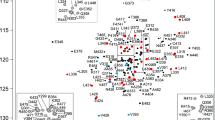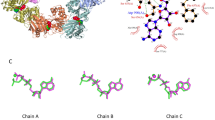Abstract
The PilF protein from the thermophilic bacterium Thermus thermophilus is a traffic ATPase powering the assembly of the DNA translocation machinery as well as of type 4 pili. Thereby PilF mediates the natural transformability of T. thermophilus. PilF contains a C-terminal ATPase domain and three N-terminal domains with partial homology to so-called general secretory pathway II (GSPII) domains. These three GSPII domains (GSPII-A, GSPII-B and GSPII-C) are essential for pilus assembly and twitching motility. They show varying degrees of sequence homology to the N-terminal domain of the ATPase MshE from Vibrio cholerae which binds the bacterial second messenger molecule c-di-GMP. NMR experiments demonstrate that the GSPII-B domain of PilF also binds c-di-GMP with high affinity and forms a 1:1 complex in slow exchange on the NMR time scale. As a prerequisite for structural studies of c-di-GMP binding to the GSPII-B domain of T. thermophilus PilF we present here the NMR resonance assignments for the apo and the c-di-GMP bound state of GSPII-B. In addition, we map the binding site for c-di-GMP on the GSPII-B domain using chemical shift perturbation data and compare the dynamics of the apo and the c-di-GMP-bound state of the GSPII-B domain based on {1H},15N-hetNOE data.





Similar content being viewed by others
Data availability
The assigned 1H, 13C, 15N chemical shifts for the apo-state and the c-di-GMP-bound-state of PilF159–302 have been deposited in the BioMagResBank (http://www.bmrb.wisc.edu/) under the Accession Numbers 27852 (apo-state) and 27853 (c-di-GMP complex).
References
Boyd CD, O’Toole GA (2012) Second messenger regulation of biofilm formation: breakthroughs in understanding c-di-GMP effector systems. Annu Rev Cell Dev Biol 28:439–462
Chou S-H, Galperin MY (2016) Diversity of cyclic di-GMP-binding proteins and mechanisms. J Bacteriol 198:32–46
Christen M, Christen B, Folcher M, Schauerte A, Jenal U (2005) Identification and characterization of a cyclic di-GMP-specific phosphodiesterase and its allosteric control by GTP. J Biol Chem 280:30829–30837
Fürtig B, Richter C, Wöhnert J, Schwalbe H (2003) NMR spectroscopy of RNA. ChemBioChem 4:936–962
Keller R (2004) The computer aided resonance tutorial. Cantina Verlag, Goldau
Keller H, Weickhmann AK, Bock T, Wöhnert J (2018) Adenine protonation enables cyclic-di-GMP binding to cyclic-GAMP sensing riboswitches. RNA 24:1390–1402
Kruse K, Salzer R, Joos F, Averhoff B (2018) Functional dissection of the three N-terminal general secretory pathway domains and the Walker motifs of the traffic ATPase PilF from Thermus thermophilus. Extremophiles 22:461–471
Markley JL, Bax A, Arata Y, Hilbers CW, Kaptein R, Sykes BD, Wright PE, Wüthrich K (1998) Recommendations for the presentation of NMR structures of proteins and nucleic acids—IUPAC-IUBMB-IUPAB Inter-Union Task Group on the standardization of data bases of protein and nucleic acid structures determined by NMR spectroscopy. J Biomol NMR 12:1–23
Pardi A, Nikonowicz EP (1992) Simple procedure for resonance assignment of the sugar protons in carbon-13 labeled RNAs. J Am Chem Soc 114:9202–9203
Paul R, Weiser S, Amiot NC, Chan C, Schirmer T, Giese B, Jenal U (2004) Cell cycle-dependent dynamic localization of a bacterial response regulator with a novel di-guanylate cyclase output domain. Genes Dev 18:715–727
Rao F, Pasunooti S, Ng Y, Zhuo W, Lim L, Liu AW, Liang Z-X (2009) Enzymatic synthesis of c-di-GMP using a thermophilic diguanylate cyclase. Anal Biochem 389:138–142
Roelofs KG, Jones CJ, Helman SR, Shang X, Orr MW, Goodson JR, Galperin MY, Yildiz FH, Lee VT (2015) Systematic identification of cyclic-di-GMP binding proteins in Vibrio cholerae reveals a novel class of cyclic-di-GMP-binding ATPases associated with type II secretion systems. PLoS Pathog 11:e1005232
Römling U, Galperin MY, Gomelsky M (2013) Cyclic di-GMP: the first 25 years of a universal bacterial second messenger. Microbiol Mol Biol Rev 77:1–52
Rose I, Biuković G, Aderhold P, Müller V, Grüber G, Averhoff B (2011) Identification and characterization of a unique, zinc-containing transport ATPase essential for natural transformation in Thermus thermophilus HB27. Extremophiles 15:191–202
Ross P, Weinhouse H, Aloni Y, Michaeli D, Weinberger-Ohana P, Mayer R, Braun S, de Vroom E, van der Marel GA, van Boom JH, Benziman M (1987) Regulation of cellulose synthesis in Acetobacter xylinum by cyclic diguanylic acid. Nature 325:279–281
Ryan RP, Fouhy Y, Lucey JF, Crossman LC, Spiro S, He Y-W, Zhang L-H, Heeb S, Cámara M, Williams P, Dow JM (2006) Cell-cell signaling in Xanthomonas campestris involves an HD-GYP domain protein that functions in cyclic di-GMP turnover. Proc Natl Acad Sci USA 103:6712–6717
Salzer R, Herzberg M, Nies DH, Joos F, Rathmann B, Thielmann Y, Averhoff B (2014a) Zinc and ATP binding of the hexameric AAA-ATPase PilF from Thermus thermophilus: role in complex stability, piliation, adhesion, twitching motility, and natural transformation. J Biol Chem 289:30343–30354
Salzer R, Joos F, Averhoff B (2014b) Type IV pilus biogenesis, twitching motility, and DNA uptake in Thermus thermophilus: discrete roles of antagonistic ATPases PilF, PilT1, and PilT2. Appl Environ Microbiol 80:644–652
Salzmann M, Pervushin K, Wider G, Senn H, Wuthrich K (1998) TROSY in triple-resonance experiments: new perspectives for sequential NMR assignment of large proteins. Proc Natl Acad Sci USA 95:13585–13590
Sattler M, Schleucher J, Griesinger C (1999) Heteronuclear multidimensional NMR experiments for the structure determination of proteins in solution employing pulsed field gradients. Prog Nucl Magn Reson Spect 34:93–158
Shen Y, Bax A (2013) Protein backbone and sidechain torsion angles predicted from NMR chemical shifts using artificial neural networks. J Biomol NMR 56:227–241
Sklenář V, Peterson RD, Rejante MR, Feigon J (1993) Two-and three-dimensional HCN experiments for correlating base and sugar resonances in 15N, 13C-labeled RNA oligonucleotides. J Biomol NMR 3:721–727
Solyom Z, Schwarten M, Geist L, Konrat R, Willbold D, Brutscher B (2013) BEST-TROSY experiments for time-efficient sequential resonance assignment of large disordered proteins. J Biomol NMR 55:311–321
Sudarsan N, Lee ER, Weinberg Z, Moy RH, Kim JN, Link KH, Breaker RR (2008) Riboswitches in eubacteria sense the second messenger cyclic di-GMP. Science 321:411–413
Wang Y-C, Chin K-H, Tu Z-L, He J, Jones CJ, Sanchez DZ, Yildiz FH, Galperin MY, Chou S-H (2016) Nucleotide binding by the widespread high-affinity cyclic di-GMP receptor MshEN domain. Nat Commun 7:12481
Acknowledgements
We are very grateful to Stefanie Düsterhus for valuable help with sample preparation and analysis. This work was supported by the Deutsche Forschungsgemeinschaft (DFG) through Grant Wo 901/7-1 to JW which is a part of the DFG special focus program SPP 1879 ‘Nucleotide Second Messenger Signaling in Bacteria’ and Grant AV9/6-2 to BA. The Center for Biomolecular Magnetic Resonance (BMRZ) at the Goethe-University Frankfurt is generously supported by the state of Hesse.
Author information
Authors and Affiliations
Corresponding authors
Additional information
Publisher's Note
Springer Nature remains neutral with regard to jurisdictional claims in published maps and institutional affiliations.
Rights and permissions
About this article
Cite this article
Neißner, K., Keller, H., Duchardt-Ferner, E. et al. NMR resonance assignments for the GSPII-B domain of the traffic ATPase PilF from Thermus thermophilus in the apo and the c-di-GMP-bound state. Biomol NMR Assign 13, 383–390 (2019). https://doi.org/10.1007/s12104-019-09911-z
Received:
Accepted:
Published:
Issue Date:
DOI: https://doi.org/10.1007/s12104-019-09911-z




